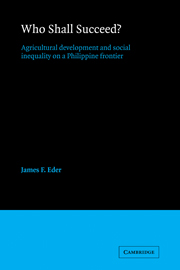How farmers choose between alternative agricultural activities with varying returns to labor was a central issue in Chapter 6. Here I explain how I estimated the returns to labor for swiddening, gardening, arboriculture and livestock shown in Table 6.3. Also discussed briefly are further details on the land, labor, and capital requirements of these production activities.
For each activity, I prepared a separate interview schedule to inquire about inputs and outputs for either a single cropping cycle or the full survey year:
Inputs
Land: location; area; whether owned or rented.
Labor: man-days of own, household, exchange, and hired labor.
Variable cash costs: seed, chemicals, hired labor, marketing.
Capital investment: fencing, wells, animals.
Outputs
Cash income.
Subsistence income.
The willingness of a number of farmers to record cash sales and daily labor inputs for periods of several months each greatly facilitated the input–output analyses of gardening and arboriculture. But limitations on the time I could devote to the agricultural economics aspects of my research made it impossible to obtain complete input–output data for all the productive activities on the 37 sample farms I chose to study wealth and income (see Appendix C). I did calculate cash income, subsistence income, and variable cash costs for all activities pursued on the entire sample of farms, and I completed analyses of labor productivity for 30 swiddens, 10 gardens, and several tree crops and livestock enterprises.
